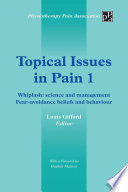
Topical Issues in Pain 1: Whiplash: science and management Fear-avoidance beliefs and behaviour
Pain is the most frustrating condition a physiotherapist encounters. This is the first yearbook of the Physiotherapy Pain Association for Chartered Physiotherapists. It considers two challenging aspects of pain in physiotherapy practice and provides insights and approaches to management that can be applied by all clinicians. Part 1 critically reviews pathology, pain mechanisms and current therapies and offers a biopsychosocial approach to assessment, prevention, and management of pain following whiplash injury. It assists the reader to understand and work with people who have developed chronic pain. Part 2 considers the relationship between fear and anxiety and activity and exercise behaviour; it describes an approach to back pain rehabilitation that incorporates an understanding of the key elements of fear-avoidance. In particular, it shows how the language that clinicians use may assist patients to develop positive attitudes that foster coping mechanisms. The Physiotherapy Pain Association Yearbooks are written by clinicians for clinicians. Each volume reviews the literature and presents best practice in a lively and understandable text. All clinicians will benefit from the straightforward advice.
Utgiven: 2013
ISBN: 9781491876763
Förlag: AuthorHouse
Språk: Engelska
Sidor: 242 st
Pain is the most frustrating condition a physiotherapist encounters. This is the first yearbook of the Physiotherapy Pain Association for Chartered Physiotherapists. It considers two challenging aspects of pain in physiotherapy practice and provides insights and approaches to management that can be applied by all clinicians. Part 1 critically reviews pathology, pain mechanisms and current therapies and offers a biopsychosocial approach to assessment, prevention, and management of pain following whiplash injury. It assists the reader to understand and work with people who have developed chronic pain. Part 2 considers the relationship between fear and anxiety and activity and exercise behaviour; it describes an approach to back pain rehabilitation that incorporates an understanding of the key elements of fear-avoidance. In particular, it shows how the language that clinicians use may assist patients to develop positive attitudes that foster coping mechanisms. The Physiotherapy Pain Association Yearbooks are written by clinicians for clinicians. Each volume reviews the literature and presents best practice in a lively and understandable text. All clinicians will benefit from the straightforward advice.
Begagnad bok (0 st)
Varje vecka tillkommer tusentals nya säljare. Bevaka boken så får du meddelande när den finns tillgänglig igen.



